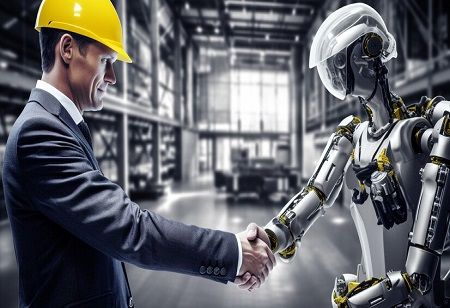
Eye-tracking smart content lenses based on radio frequency tags are being developed by scientists from Nanjing, China. These are developed for various applications such as healthcare and augmented reality. These lenses are biocompatible & imperceptible and hence do not require any battery or conventional silicon chips. Smart contact lenses which can track numerous health factors can be utilized for human-machine interaction and these rely on tracking the eye movements leveraging several methods such as pupil center corneal reflection as well as electrooculography.
Today, in the manufacturing industry, Human-Machine Interaction technologies have become a cornerstone and it has helped in driving significant enhancements in efficiency. These technologies not only help in streamlining operations by improving the way machines interact with humans but they also reduce errors and increase productivity.
Human-Computer Interaction (HCI) Market Size was valued at USD 546,647.5 million in 2022. The Human-Computer Interaction (HCI) Market industry is projected to reach USD 1,663,884.1 million by 2030, exhibiting a compound annual growth rate (CAGR) of 15.4% until 2030. In this article let us look at the various advancements in HMI technologies within the manufacturing industry, exploring the impact on automation, robotics, predictive maintenance, augmented reality, and others. Through these lenses we can understand how HMI technologies are revolutionizing the manufacturing processes & contributing to a more efficient as well as productive industrial landscape.
Implementing Natural Language Processing
Human-machine interactions can be enhanced to a greater extent by allowing users to communicate using natural languages with machines either via voice or text. Voice commands for instance enable users in controlling machines hands-free and these can be quicker & more convenient than typing or clicking, particularly in situations where manual input is impractical.
Intelligent chatbots that are powered by Natural Language Processing can also enhance efficiency by offering instant information & support. These chatbots can handle several inquiries from customer service for technical support, allowing human employees in order to focus on several complex tasks. By understanding and responding to some of the user queries in a natural as well as conversational manner, chatbots should improve the complete user experience as well as streamline interactions.
Holger Kenn, director of Business Strategy for AI and Emerging Technologies at Microsoft, considers individual workers to be the driving force behind emerging HMI technologies. “We’re seeing an infusion of consumer technology into the industrial field, where techniques like large language models (LLM) can transform massive printed manuals into interactive real-time training and provide HMI developers with more options to design for accessibility.”
Enhancing Usability & User Experience
A crucial aspect of enhancing efficiency via HMI technologies is improving user experience & usability. Interfaces must be designed for being intuitive & user-friendly, decreasing the time as well as effort that is needed for users in order to accomplish tasks. This comprises creating simple as well as consistent designs which users that can understand & navigate easily. For example, the learning curve can be reduced significantly by employing familiar symbols, layouts, & icons.
Another important component is responsive design ensuring that interfaces function well in numerous screen sizes & devices. This adaptability is specifically important in the present world where users most often switch between tablets, smartphones, and desktops. A responsive interface not only offers a seamless experience but it also helps in maintaining efficiency irrespective of the device used.
“One of the most seamless ways that AI is enhancing HMI design is with the use of AI-powered assistants. This includes Siri, Alexa, Google Assistant, and more which allow human interactions with devices using natural language. AI’s impact on the integration of voice commands in various interfaces is evident,” says Nick Talbot, Global Head of Design & Innovation, Tata Elxsi.
“Similarly, AI’s role in personalization is notable. AI algorithms analyze user behavior, preferences, and historical data to personalize interfaces and adapt them to individual users for tailor-made HMI experiences,” he adds.
Leveraging AI & ML
AI/ML play a vital role in optimizing Human-Machine interaction technologies and these can be used for implementing several features that include predictive text & autocomplete. This helps users in completing tasks faster by suggesting phrases or words as they type. These types of features are specifically useful in applications where speed & accuracy are paramount, like messaging or data entry.
Another significant benefit of Artificial intelligence and Machine Learning is personalization. By analyzing user behavior as well as preferences, AI/ML can customize the user experience as per the user’s requirements. For instance, based on the user’s recommendation systems on e-commerce websites leverage machine learning for suggesting products which a user is likely to be interested in. This not only improves the user satisfaction but it also increases efficiency by reducing the time users spend in searching for their items.
“Despite the entire buzz around AI triggering a massive, wholesale transformation of manufacturing operations, Tom Hummel, VP of Technology at Rapid Robotics, believes that actual use cases will focus on the human part of the equation, not the machines”.
“As AI is introduced on the manufacturing floor, it won’t necessarily change what robotics has been doing a million times over for years,” he adds.
Some of the top companies operating in the global human machine interaction technologies include Yaraku, Inc., Perceived, Omron, Fanuc Corporation and others.
Enhancing efficiency through HMI technologies comprises a comprehensive approach which includes improving usability, implementing advanced technologies such as Artificial Intelligence & Natural Language Processing to increase automation, optimize performance, emphasize security and privacy, ensure robust training & support, utilize data analytics & foster human-machine collaboration.
By focusing more on these segments, enterprises can build more effective, efficient as well as satisfying human-machine interactions which lead to better outcomes as well as increased productivity. Furthermore, the ongoing evolution of Human-machine interaction technologies promises greater efficiency as well as innovation in the future, and this makes it an exciting segment for continued exploration & development.

